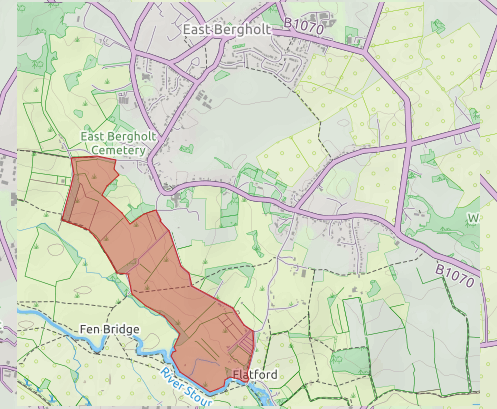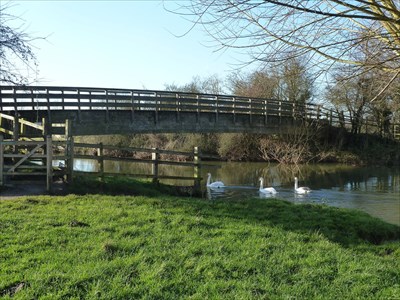Conservation Area Extension 5 - Fen Bridge & Flatford
Flatford itself is a small cluster of buildings on the banks of the River Stour to the south of East Bergholt. It includes the famous Flatford Mill, together with other historic structures such as the lock, the bridge, the Granary, Valley Farmhouse and Willy Lott’s Cottage.
It is served by Flatford Lane on the north side of the river, which runs in a loop from the crossroads at Gandish Road/White Horse Road junction downhill towards the National Trust CarPark, and then uphill to East Bergholt Church.
The area is within the Dedham Vale AONB; with cross-country pedestrian and boat access to Dedham itself. The land for consideration for Conservation Area status also comprises the fields and woods either side of Flatford Lane, and the mill-related properties on the riverside.
Details
Historical Importance:
Flatford Mill is world-famous as an essentially English historical site largely due to:
· The many classic paintings of the location made by John Constable in the early 19thC.
· The protection, restoration and stewardship of former owner Mr Parkington and The National Trust who have looked after the buildings and landscape.
John Constable also produced many paintings and sketches from various viewpoints on Flatford Lane, mostly looking across Dedham Vale towards Stratford St Mary, Dedham and Brantham. Fen Lane has also featured in some well-known views, such as “The Cornfield “ (1826).
There is evidence of even earlier remains which give clues to the history of Flatford way before Constable’s father made a success of the mill. There is an old moat which surrounded a former house on the Stour, and there is the records of a Saxon church (and a Parsonage) in Church Field, of which part of a stone font survives. Among the collection of listed buildings in this small enclave is Valley Farmhouse, which survives intact as an excellent architectural example from the 14thC.
Assessment of Special Interest:
· The ensemble of mill buildings, barns, houses, locks and river structures, together with the landscapes around the Stour and Flatford Lane are acknowledged by historians and art experts to be nationally significant.
· Many of John Constable’s most important paintings are of the Flatford Mill area, where the views have changed very little since his time.
· Flatford Lane itself and the fields either side have not changed in configuration or character for centuries, and are also the sites of many of Constable’s views. Aesthetic and historical importance of these landscapes cannot be ignored.
· The area is part of the Dedham Vale AONB.
Reasons for Inclusion in Conservation Area:
- Flatford Mill, together with the buildings and river structures on the banks of the Stour, is nationally important and often referred to as quintessentially English. The architecture, the landscape and the views have been carefully protected and restored in order to keep the place so special.
- Flatford Lane, and the fields on both sides of it, have not materially changed in hundreds of years. The route and the area offer a sequence of stunning views and beauty spots.
- John Constable gave the Mill, Flatford Lane and Fen Lane international recognition through his iconic paintings of 200 years ago.
- The area sits within the Dedham Vale AONB, but can enjoy reinforced heritage protection by being included in an extended Conservation Area for East Bergholt.
Relevant Reading , Documentation, Maps and Photographs:
- Books on Constable (many and various…to be listed…?)
- Heritage Collective Study (2020)
- National Trust website and books on Flatford
- Glossary of listed buildings
- Historical archive material (e.g. John Willett’s memories 1920 onwards…)
- Other material…Joyce, Tamsin and Clive?
- Old photographs, paintings and maps (Brassier and others… OS maps from 1887 and 1905…)


